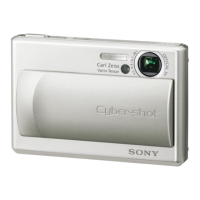
Do you have a question about the Sony Cyber-shot DSC-T1 and is the answer not in the manual?
| Camera Type | Compact |
|---|---|
| Megapixels | 5.1 MP |
| Sensor Type | CCD |
| Optical Zoom | 3x |
| Digital Zoom | 6x |
| Focal Length (35mm equivalent) | 38-114mm |
| ISO Range | 100 - 400 |
| Video Resolution | 640 x 480 |
| Battery Type | Lithium-Ion |
| Battery Model | NP-FT1 |
| Weight | 175 g |
| Dimensions | 91 x 60 x 21 mm |
| Sensor Size | 1/2.5" |
| Screen Size | 2.5-inch |
| Storage Media | Memory Stick Duo |
| Dimensions (W x H x D) | 91 x 60 x 21 mm |
| Aperture Range | f/3.5 - f/4.4 |
Instructions for operating the unit before use.
Section for recording model and serial numbers for reference.
Safety warnings and compliance information for U.S. customers.
Details on FCC compliance and interference reduction measures.
Information and guidance on recycling lithium-ion batteries.
Specific safety and compliance notices for UK and European customers.
Guidance on trial recording and backing up data to prevent loss.
Precautions for handling the camera, lens, and screen to prevent damage.
Advice on where to place the camera to avoid interference.
List of registered trademarks and product names used.
Identification and numbering of external camera parts.
Identification and function of camera buttons and controls.
Details of the USB cradle and its input/output connectors.
Step-by-step guide for connecting and disconnecting the camera.
Steps for installing the battery and connecting the charger.
Connecting the power cord and AC adapter for charging.
Charging the battery directly using the AC adaptor.
Explanation of the battery indicator on the LCD screen.
Guide on connecting and using the AC adaptor.
Information on power sources for international use.
Steps for powering the camera on and off.
How to navigate menus and make settings using the control button.
Procedure for setting the camera's date and time upon first use.
Steps for selecting and entering date and time values.
Step-by-step guide for inserting and removing the Memory Stick Duo.
How to select the desired image size for still photos.
Guidelines for choosing image sizes and their usage.
Table showing image counts per memory stick capacity.
Guide to shooting in auto mode with focus and exposure adjustments.
Explanation of how the mode switch changes camera functions.
Details on auto and program shooting modes.
Explanation of auto focus and its limitations.
How to check the last captured image and delete it.
Explanation of indicators displayed on the LCD during shooting.
How to operate the camera's zoom function.
Details on optical, smart, and precision digital zoom.
Guide for shooting subjects at close distances using Macro mode.
Steps for using the self-timer for delayed shots.
How to select different flash modes like Auto, Forced, and Slow Synchro.
How the AF illuminator aids focusing in dark conditions.
Guide to superimposing date and time onto still images.
Steps to configure date/time imprint options in the Setup menu.
Using the camera in Magnifying glass mode for close-up details.
How to use Twilight mode for shooting in low light.
Using modes for landscapes, snow, and beach scenes.
Using modes for fast action and fireworks.
How NR slow shutter removes noise from images.
How to view single images on the LCD.
Navigating through nine and sixteen image index displays.
Steps to connect the camera to a TV for viewing images.
Matching camera's video output to TV system (NTSC, PAL, SECAM).
How to delete individual images from the camera.
How to select and delete multiple images from index views.
Guide on how to format the Memory Stick Duo.
Steps to execute the formatting process and confirm completion.
Guide on how to navigate and change settings in the camera menu.
How to access and change items within the Setup screen.
Options for selecting image quality (Fine/Standard).
Steps to create new folders on the Memory Stick Duo.
How to select a different folder for image storage.
Explanation of AF range finder frame types (Multipoint, Center, Spot).
Details on Single AF, Monitoring AF, and Continuous AF.
How to use AF lock for precise focusing, especially at edges.
Using Focus Preset for specific subject distances.
How to manually adjust exposure using EV settings.
How to display and interpret image histograms.
Using histograms to guide exposure adjustments.
Explanation of multi-pattern and spot metering.
How to shoot three images with different exposures.
Steps to set up and shoot with Exposure Bracket.
How to manually adjust white balance for different lighting conditions.
How to control the intensity of the flash.
Using burst modes for continuous shooting.
Details on Speed and Framing Priority burst modes.
How to use Multi Burst mode for rapid sequence shooting.
Shooting small images suitable for email transmission.
Setting intervals for Multi Burst shooting.
Recording audio along with still images.
Using effects like Solarize, Sepia, and Neg. Art.
Steps to select and apply digital picture effects.
How to select folders for viewing stored images.
Using playback zoom to enlarge and view parts of an image.
How to crop and save enlarged images.
Setting up and playing back image slide shows.
How to rotate images for correct orientation.
How to play back Multi Burst images continuously or frame-by-frame.
Controlling playback frame by frame using jog dial.
How to delete all frames of a Multi Burst sequence.
How to protect individual images from accidental deletion.
How to change the size of recorded images.
How to mark images for printing using DPOF.
Marking images for printing from index screens.
How to unmark images and exit the DPOF function.
Steps for recording movies and selecting resolution.
How to play, pause, adjust volume, and navigate movies.
How to delete unwanted movie files.
How to cut movies and delete parts.
Detailed steps for cutting movies.
How to delete specific parts of a movie.
System requirements for copying images on Windows.
Guide for installing the USB driver on Windows.
Steps for installing the Image Transfer application.
Steps for installing the ImageMixer application.
Steps for connecting the camera to a computer via USB.
Procedure for safely disconnecting the camera during USB connection.
Copying images using Image Transfer on older Windows versions.
Changing settings for the Image Transfer software.
Copying images manually via File Explorer.
Steps to troubleshoot when the removable disk icon doesn't appear.
Guide to copying images using the XP AutoPlay Wizard.
How to view copied images in the My Documents folder.
Explanation of folder structure and file naming conventions.
Details on file names (DSC, MOV, THM) and their meanings.
How to copy image files from computer back to the camera.
System requirements for copying images on Macintosh.
How to view images on a Mac computer.
Configuring application for E-mail mode image files.
Basic steps like checking tables, resetting, and consulting service.
Solutions for battery charging and power-related problems.
Solutions for battery depletion and sudden power off.
Solutions for LCD not turning on or subjects not being visible.
Solutions for blue LCD screen during movies and out-of-focus images.
Troubleshooting zoom not functioning and image brightness problems.
Solutions for image noise and inability to record images.
Troubleshooting flash not working and Macro function issues.
Solutions for playback errors and TV display problems.
Solutions for inability to delete/edit images and DPOF marks.
Checking OS compatibility and USB driver installation.
Steps to resolve computer not recognizing the camera.
Solutions for problems copying or transferring images.
Solutions for interrupted movie playback and printing errors.
Solutions for insertion, recording, formatting, and deletion errors.
Solutions for camera not working and becoming warm.
Troubleshooting unclear indicators and fogged lenses.
Meanings and corrective actions for Memory Stick errors.
Explanations for 'Cannot divide' and 'Invalid operation' messages.
Understanding self-diagnosis codes (C:32, C:13, E:61, E:91) and corrective actions.
Estimates for images in E-mail and Voice modes based on memory and quality.
Estimates for movie recording times based on memory and quality settings.
Explains settings accessible under the Camera menu.
Details on Voice, E-Mail, Multi Burst, Exp Brktg, etc. modes.
Settings for Flash Level, Picture Effect, Saturation, Contrast, Sharpness.
Settings for exposure value, focus, and metering.
Settings for white balance and picture effects.
Menu options for folder selection, image protection, and DPOF marking.
Menu options for slide shows, resizing, rotating, and dividing movies.
Settings under the Camera menu (AF Mode, Digital Zoom, Date/Time, etc.).
Setup options for Memory Stick formatting and folder creation.
Settings for LCD brightness, backlight, beep, and language.
Settings for file numbering, USB connection, video output, and clock.
Warnings about extreme temperatures, dust, vibration, and carrying the camera.
Instructions for cleaning parts and preventing moisture damage.
Details about the internal battery for settings and charging.
Information on compatible Memory Stick types and functions.
Guidelines for using Memory Stick Duo, including write-protect switch.
Instructions for using the supplied Memory Stick Duo Adaptor.
Tips for maximizing battery performance and life.
Guidance on storing batteries and understanding battery life.
Technical details of the camera body, lens, and exposure controls.
Details on connectors, USB cradle, and AC adaptor.
Specifications for the NP-FT1 battery pack.
List of accessories supplied with the camera.
Identification of indicators displayed during still image shooting.
Identification of indicators displayed during movie shooting.
Identification of indicators displayed during still image playback.
Identification of indicators displayed during movie playback.
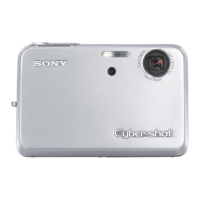
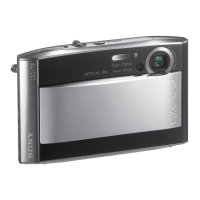

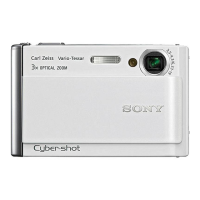

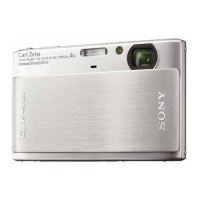
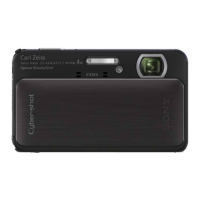
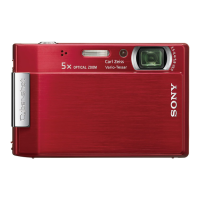



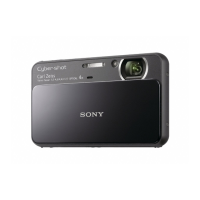
